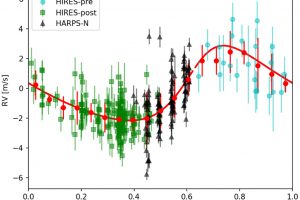Planets in binary systems. The study: “The HADES RV Programme with HARPS-N@TNG VIII. Gl15A: A multiple wide planetary system sculpted by binary interaction” of M. Pinamonti (INAF-OATo) published on A&A

In our Galaxy, a large fraction of stars is part of binary systems. For instance, the study of Duquennoy & Mayor (1991) suggests a binary fraction of 57% for solar type stars. A slightly smaller binary fraction is expected for less massive stars. Among pre-Main Sequence stars, several binary systems are known to host a circumbinary disk. These disks are the version for binary systems of the protoplanetary disks: disks of dust and gas orbiting single stars with an age of 5-15 million of years, and that may evolve in planetary systems. It is thus important to understand whether the chances that stars in binary systems have to form planetary systems are different than of single stars, and whether the presence of a companion star affects the evolution and final architecture of the planetary system.
Astronomers don’t yet know the answers to these questions. In fact, only a small fraction of the more than 3500 exoplanets known to date are part of binary systems. One interesting case is the exoplanet orbiting around the M1 star Gl15A, discovered in the 2014 and classified as a super-Earth. Gl15A, in fact, is part of a binary system which is only 11.7 light years away from the Sun. The companion of Gl15A, Gl15B, is a M3.5 star, orbiting at 146 Astronomical Units (AU, 1 AU is the mean Earth-Sun distance, equal to 150 million of km) around Gl15A with a period of 2600 years.
The planetary system of GI15A is the subject of the study: “The HADES RV Programme with HARPS-N@TNG VIII. Gl15A: A multiple wide planetary system sculpted by binary interaction” of M. Pinamonti (INAF – Astronomical Observatory of Turin), recently appeared on Astronomy & Astrophysics. The authors of this study have analyzed an impressive set of radial velocity measurements covering a temporal frame of 20 years, in order to characterize the planetary system of this star. Archival observations covering 15 years have been taken from the “Precision Radial Velocity survey” made with the spectrograph HIRES of the W. M. Keck Observatory. New observations spanning 5 years have been taken with the HARPS-N spectrograph mounted on the Telescopio Nazionale Galileo. This study has confirmed the presence of the super-Earth GI15A b, also obtaining a new estimate of its mass (about 3 Earth masses). Besides, the presence of a new planet has been discovered. This planet, GI15A c, has a mass of about 36 Earth masses, typical of super-Neptunes. With its orbital period of 21 years, GI15A c is the super-Neptune with the longest orbital period known to date. This study has also demonstrated that this planetary system is affected by the presence of the companion star by the Lidov-Kozai effect. This phenomenon consists in oscillations of the eccentricity and inclination, with the same period but opposite phase, of planetary orbits due to an external perturbation, in this case the gravitational attraction of Gl15B. The astronomers of the INAF – Astronomical Observatory of Palermo J. Maldonado, L. Affer,
The figure (link) shows the radial velocity signal of GI15A c.
of Mario Giuseppe Guarcello ( follow mguarce)
